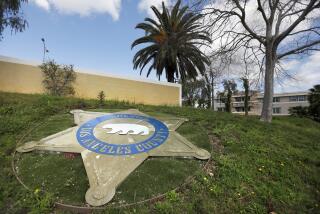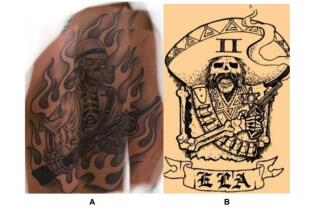Must Reads: After decades of problems, new allegations surface of a secret clique within L.A. County Sheriff’s Department
- Share via
For decades, the Los Angeles County Sheriff’s Department has struggled to combat secretive cliques of deputies who bonded over aggressive, often violent police work and branded themselves with matching tattoos.
A federal judge called out the problem nearly 30 years ago, accusing deputies of running a “neo-Nazi, white supremacist gang” named the Vikings within the Lynwood station. Others followed with names such as the Regulators, Grim Reapers, Rattlesnakes and the Jump Out Boys. Inside the county’s central jail, the 2000 Boys and 3000 Boys ran roughshod over the lockup’s toughest floors.
Now, despite past attempts by sheriff’s officials to discourage internal cliques, fresh allegations have arisen of deputies in the department’s Compton station adorned with matching skull tattoos.
One deputy acknowledged in a recent deposition that he and 10 to 20 of his colleagues at the station had the tattoos but denied there was a formal clique.
Attorneys representing the family of a black man shot by deputies during a 2016 foot pursuit have used the existence of the tattoos to argue there is a clique tied to the killing, which they allege was racially motivated.
It’s unclear whether the tattoos signal a return of a secret deputy group that celebrates violence or something more benign. But some law enforcement experts said it’s important for the Sheriff’s Department to understand what’s going on and make sure the clique mind-set has not returned.
“In addition to investigating the police shooting, the department should also look at the culture,” said Alex Busansky, a former prosecutor who served on a county commission that in 2012 found that the department’s tolerance of cliques contributed to excessive force in the jails. “A place where 20 police officers receive matching tattoos is a place where there is a mentality of us-versus-them, and that on its face is concerning.”
Sheriff’s spokeswoman Nicole Nishida declined to comment on the allegations, citing the pending litigation, but said in a statement that the agency expects deputies to meet high standards of integrity and appearance. She also acknowledged they have the right to free expression.
“Our department policy requires deputies to cover tattoos, which have become part of the cultural norm. However, when it comes to their conduct and their use of tactics, we have multiple systems of review and accountability both internally and externally. Every critical incident is exhaustively analyzed,” the statement said.
The controversy focuses on a deposition given in May by Deputy Samuel Aldama, one of the deputies involved in the 2016 shooting who at the time was assigned to the Compton station. Under oath, Aldama described a tattoo on his calf as a skull with a rifle and a military-style helmet with flames surrounding it. On the helmet are the letters “C P T” for Compton. He said he got the tattoo in June 2016, about two months before the deadly shooting.
Aldama said he knew of other deputies at the station who had tattoos like his, according to an excerpt of the deposition transcript reviewed by The Times. But he repeatedly denied that the inked art signified membership in a club.
Instead, he said, “working hard” on the job — making arrests, answering calls — was the only requirement for getting the tattoo. He described vaguely the selection process, saying that when deputies in the station determined someone in their ranks was deserving of the honor, they passed along the contact information of an artist who would make the tattoo.
In a court hearing Monday, the attorney for the dead man’s family, John Sweeney, raised the tattoos and a response Aldama gave in the deposition, saying that together they showed the deputy harbored racist feelings about African Americans when he opened fire — a serious allegation that a lawyer for the Sheriff’s Department denied.
We’ve “uncovered another one of those cliques,” like the Vikings, Sweeney told the judge.
“There truly is a history of tattoos in the Sheriff’s Department, but [Sweeney] has yet to prove that this is anything more than a station tattoo,” said Harold Becks, the county’s attorney. He did not respond to requests later on Monday for comment.
At the deposition, along with questions about his tattoo, Sweeney asked Aldama, “Do you have any ill feelings toward African Americans in general?” according to excerpts of the deposition reviewed by The Times.
After asking the attorney to repeat the question, Aldama said he did have feelings. The attorney asked him to elaborate.
“They’re just human beings, sir,” Aldama replied after a long silence.
Sweeney asked again if the deputy had any ill feelings, emphasizing “ill.” Aldama, after another lengthy pause, said that he did.
About a minute later, Aldama told Sweeney he had not understood the questions about African Americans.
“I don’t have any ill feelings,” the deputy said.
Matching tattoos have long been part of a fraternity subculture in the Sheriff’s Department, dating at least to 1971 with the Little Devils at the East Los Angeles station.
Seven deputies were fired in 2013 after an investigation into the Jump Out Boys, a group of gang enforcement officers who were accused of glorifying shootings by deputies. Their signature tattoo was a skeleton holding a revolver. Whenever a deputy in the group was involved in a shooting, he would earn extra ink of smoke coming out of the gun.
Deputy cliques were also criticized by the Citizens’ Commission on Jail Violence, a blue-ribbon group that issued harsh findings in 2012 about systemic dysfunction in the department, including the use of excessive force against inmates. The commission recommended that the agency ban visible tattoos associated with the groups because they had sometimes been used to reward aggressive behavior. In one episode, a deputy in the 2000 Boys broke the eye socket of a complacent inmate during a beating to “earn his ink” — a tattoo with the Roman numeral “II.”
Sheriff Jim McDonnell, who was part of the commission, did not respond to requests for comment on Monday.
At his federal trial on obstruction-of-justice charges in 2016, former Undersheriff Paul Tanaka was assailed by prosecutors for being a tattooed member of the Vikings. On the stand, Tanaka denied allegations he had encouraged aggressive, improper tactics by the Viking members, saying the group did not represent anything sinister.
The latest controversy emerged in a legal battle over the Aug. 25, 2016, killing of Donta Taylor.
About 8:30 p.m., Aldama and his partner, Mizrain Orrego, were assigned to a gang-suppression detail in a marked car when they saw Taylor, 31, walking on Wilmington Avenue in an area known to be controlled by the Cedar Bloc Pirus gang, according to a district attorney’s review of the shooting. Taylor was wearing a red hat with the letter C on it, which the deputies took as a sign he was affiliated with the gang. They told investigators he appeared to be holding something in his waistband, the report said.
The deputies told investigators that when they pulled alongside Taylor to ask if he was on parole or probation, he pulled a handgun from his shorts and ran, according to the report. Both deputies chased Taylor on foot and called for backup on their radios, saying they were in pursuit of a man with a gun.
In an attempt to corner him, the deputies separated and pinned him in along a wash. Orrego, who was positioned around a corner from his partner, said he fired several times when he saw Taylor approaching with a gun in his hand. Hearing the shots and seeing Taylor run into view, Aldama then fired as many a dozen rounds. Orrego said he fired again two or three times when he saw Taylor turning back in his direction. An autopsy showed Taylor had been shot six times.
Despite an extensive search, no weapon was recovered. Sheriff’s officials said tests on Taylor’s pockets and waistband turned up gunshot residue that was consistent with a handgun.
After reviewing the shooting, the district attorney’s office found the deputies acted reasonably and should face no criminal charges.
Efforts to contact Orrego and Aldama were unsuccessful. Nishida said she would alert the deputies that a Times reporter wanted to speak with them.
After the hearing Monday, Sweeney cited an arrest the two deputies made months before the killing that he said mirrored what happened to Taylor.
In January 2016, the deputies rode their patrol car up to Sheldon Lockett, who was standing with a friend in front of his godmother’s house, and pulled their handguns on him, according to a federal lawsuit Sweeney filed for Lockett.
The lawsuit alleged that although he was unarmed and not doing anything illegal, Lockett fled out of fear. The deputies chased him and radioed falsely that they were chasing a man with a gun, the lawsuit claims. When they found him, Aldama and Orrego severely beat and Tased Lockett while repeatedly using a racial epithet, according to the lawsuit. Then, with Lockett subdued and in custody, one of the deputies “rammed the end of a police baton” into Lockett’s eye socket.
The county has yet to respond formally to the lawsuit.
Looking to bolster his legal claim that sheriff’s officials share culpability in Taylor’s death, Sweeney said the department failed to investigate the deputies after Lockett’s mother complained about the arrest.
“Had they investigated this, Donta Taylor would be alive today,” Sweeney told The Times.
Follow @joelrubin on Twitter
More to Read
Sign up for Essential California
The most important California stories and recommendations in your inbox every morning.
You may occasionally receive promotional content from the Los Angeles Times.















